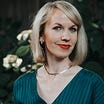After nearly ten years of chosen childlessness with my husband then a daunting decision to try, I warmed to the wonder of my first pregnancy during Advent. Then, the week before Christmas, just as the word readied to celebrate the ultimate pregnancy and birth narrative, I miscarried. It was Advent’s week of joy. It was also the winter solstice, and yes, the world indeed felt dark. I soon became pregnant again, and my daughter’s due date was one year nearly to the day after our loss.
As every mother who has lost knows: time can be tricky.
As the days crossed into December, I found myself living on a strange continuum: every day carried me further from that final winter solstice night in which I shared a body with our first, and every day carried me closer to our daughter’s due date. One year ago, my body had gone into labor for the first time. Now I waited for contractions to again come calling to tell what I hoped would be a very different kind of birth story. It certainly felt like Advent’s Time Between. This circle of a year, December to December, Advent to Advent, held so much.
What was a woman to make of this except to feel it all: ache and anticipation, sear of loss and fire of love. I stretched taut in all directions. If love is such expansion, then let me expand. Let my love grow eschatological: reaching forward, reeling back. Let it rake the sky and shake the boughs of the stars until the future is now and the long ago is vibrantly here.
There is a future, however far, in which we will be together again—when the brittle borders of mortal time finally break. For now, I wanted to be reminded of the ways we are interconnected.
In pregnancy, a small measure of fetal cells make a mysterious migration—crossing the placenta to home in their mother’s bloodstream, breast tissue, brain, and other organs, even grafting into her heart tissue. A woman in her third trimester of pregnancy might have up to 6 percent of fetal DNA circulating in her bloodstream.1 Studies support the leading theory that this comingling of cells happens with every pregnancy, even those that end in miscarriage. Scientists call it microchimerism, named for the chimera of Greek mythology, a creature composed of many creatures—lion, goat, and dragon.
This concentration of fetal cells naturally wanes after pregnancy, yet their presence remains in the mother’s body for decades, even a lifetime. The oldest woman in one study, for instance, was ninety-four years old, and yet her body still harbored the Y chromosomes of her decades-ago-born son.2
Is free-floating DNA enough for those who long to live life together? Hardly. No. But if anything is true, it must be true not only in large scale, but at the smallest. And it seems to me that our bodies tell the story of the great belonging for which we are meant, and this belonging runs deep—down to the veins, down to a single twist of double helix.
It was Advent again, and I wondered what it might mean to have sister cells swimming together in my bloodstream for a lifetime. What it means to be carried in the circulation of our mothers through the turning of the years. What it means to carry our children, long after they have left our bodies—for something other to become part of you, to remain.
If the pattern of any double helix is a signature unto its own, unlike any other, then the body of a mother speaks such a name for life. Kept close—closer than just about anything—in the sanctuary of her pulse. Surely we are creatures meant to be kindred and carried—by our mothers, by each other, by God.
Thank you for supporting women and the arts. We are still here, ten years later, because of you. ❤️
Nancy Shute, “Beyond Birth: A Child’s Cells May Help or Harm the Mother Long after Delivery,” Scientific American, April 30, 2010.
William F. N. Chan et al., “Male Microchimerism in the Human Female Brain,” PLOS ONE (2012), https://doi.org/10.1371/journal.pone .0045592.







